Growing onions for greens in winter. Growing in greenhouses and greenhouses. Growing green onions from sets
Making early spring year-round is real. A technology that involves growing green onions in a greenhouse in winter will help in this. Information about the features of the process, from the necessary technical equipment and ending with the sale of the grown product, is a good help for the implementation of the planned business. Review the instructions for variety selection, planting and care to provide vitamins to your family and supplement your household budget by selling greenery.
Growing up for sale
How to grow greens all year round in a greenhouse
Growing green onions on a feather continuously throughout the year is certainly profitable - a properly planned planting in a greenhouse makes it easy to implement an idea. It makes especially sense to take care of the availability of greenery for sale on the days before the holidays.
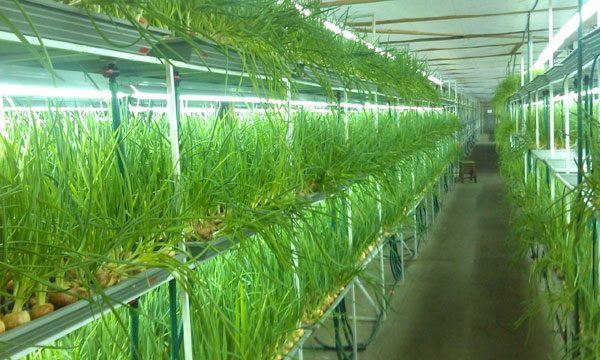
Industrial greenhouse
Greenhouse requirements
It is expedient to increase production volumes most actively from October to April, when the cultivation of onion feathers in open ground actually absent. To do this, the greenhouse provides for:
- Lighting. After all, a natural sunny day is extremely insufficient. If there is little light, the onion will still reach for the source of minimal light (the stems will become thin, elongated, pale, brittle).
- Heating. Of course, low temperatures are contraindicated for growing greenery. It should be possible to adjust the heat so that the air is at the right temperature.
- Watering. Drip irrigation effectively provides the required amount of water to the moisture-loving plant.
- Availability of special shelving. Allows you to get more harvest using the available area.
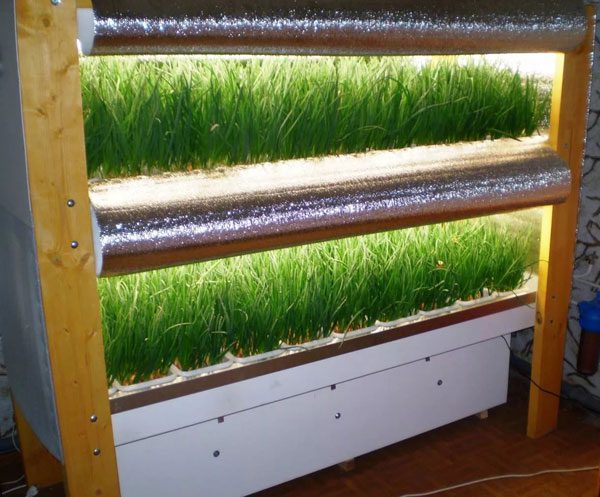
Backlit shelving
A durable polycarbonate greenhouse is required for year-round operation. Film greenhouses are not suitable, since it is unrealistic to organize heating in them. Glass structures can be used, but they are more difficult and expensive to build.
The question of whether it is possible to plant onions in a greenhouse without observing the above conditions is controversial. At first, it is permissible to skip unless the item on installing racks. And the implementation of agrotechnical aspects to get a good harvest is a must.
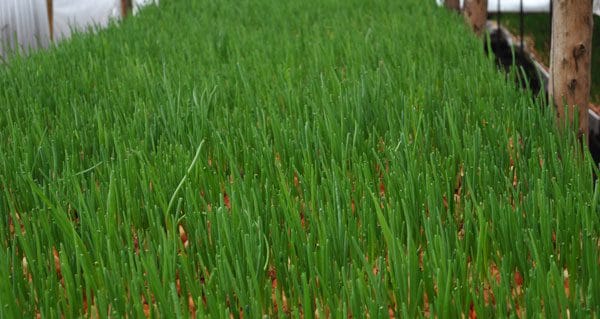
Excellent yield and appearance vitamin greens
Onion variety selection
Onions for forcing for greens is a classic option. But there are other varieties that are gaining popularity, purposefully designed to grow "green storehouse of vitamins."
- Slime onion. Due to the fact that it does not have a dormant period, this variety is grown all year round. The moderate aftertaste of garlic gives a special taste originality. It grows rapidly, greens of the required size appear very quickly, and are unpretentious in their care. Greens are cut up to five times per season. An excellent option for growing for sale.
- Schnitt. Its visual distinguishing feature is its thin stems. The first crop is harvested at least 3-4 weeks after planting. This look is also quite attractive to customers.
- Bow-Batun. Such onions for feathers in the greenhouse are grown starting in November, since they have a small dormant period (about 45 days). The variety is intended only for producing a green feather.
- Shallot. Longest sleep period. Therefore, planting is carried out in December.
- Multi-tiered bow. Yielding, frost-resistant. The taste is spicier than other varieties. Instead of flowers, small bulbs grow in rows or tiers, which is what its name deserves.
The final decision on the choice of a variety or varieties is made on the basis of a study of the product sales market, an analysis of the available growing conditions, and personal preferences.
Seed preparation
Of the possible options for planting onions on a feather in a greenhouse (with bulbs, seeds, seedlings), the most popular, requiring less time and labor to obtain a good result, is the first. The main tips on how to plant onions on greens in a greenhouse boil down to the goal of "waking up" it, activating growth. For this:
- Selected onion heads without damage, small in size (on average 3-4 cm in diameter) are cleaned of excess husk.
- Placed in warm water (water temperature 38 ° C, soaking duration - 12 hours);
- Wet vegetables are dried.
- The top of the seed bulb is cut off. In contact with oxygen, they stimulate growth.
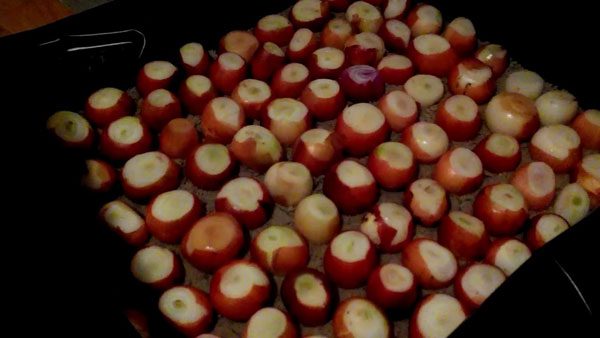
The final stage of preparation of planting material
If they decide to plant with seeds, then in order to prevent the seedlings from getting sick, do the following:
- The seeds are kept in water at room temperature for about 20 hours (water change - three times).
- Then it is soaked in a weakly concentrated solution of potassium permanganate and washed with water.
- For the final soaking, use a special "epina" agent (a few drops per 100 g of water).
The technology of growing onions on a feather
To get a harvest in winter, they decide how to plant onions in a greenhouse in the fall. To do this, prepare everything necessary for winter growth (equipped greenhouse, fertilized soil) and acquire high-quality planting specimens. More details about the conditions and stages of the growing process:
- Preparation of high-quality soil. The soil should not be sandy. Wood chips are added to retain moisture. Enriched with mineral fertilizers.
- Required temperature. In the daytime - 20 ° C, at night 13-14 ° C is enough.
- Additional illumination. Provide 12 hours of daylight for growing onions.
- Proper watering... Warm water for about three days once.
- Fertilizing the future harvest. A week after planting, they are fed with such a mixture: ammonium nitrate and potassium chloride in equal proportions (20 g each), slightly more superphosphate (30 g).
- One of the best bulb planting methods is paving. When doing the work, they try not to press the seed vegetables into the soil too much, most of the head remains on top, and the bulbs are in close contact with each other. Tape method: the distance between the rows is about 10-15 cm, between the bulbs - 5 cm maximum.

Bridge planted bulbs
The technology of growing onions on a feather in a greenhouse, as you can see, is not difficult. If an equipped greenhouse is the owner's way of earning money, then it is quite acceptable to start with the cultivation of greenery.
Features of growing for sale
If in winter green onions in a greenhouse in small quantities are able to provide vitamins to family members, then, of course, when it comes on cultivation for sale, it is expected to produce increased volumes of greenery. More profitable sales - in winter, this is natural. If planted in the fall, then given the fact that distillation occurs rather quickly, there will be guaranteed goods by winter.
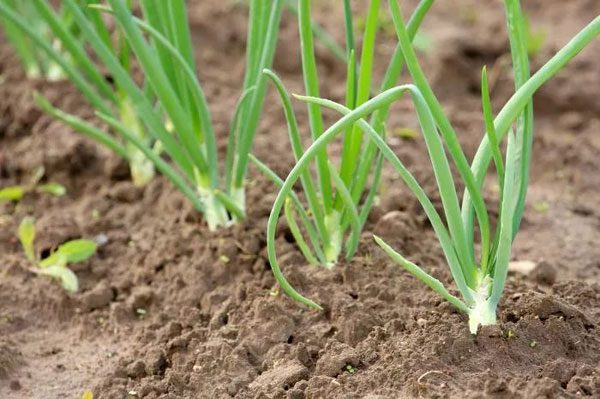
Rapid growth and quick profits
Advantages of the greenhouse method
Growing onions in a greenhouse in winter has definitely beneficial points:
- The yield is higher compared to growing outdoors. They get more products, and profit, respectively, too.
- Production of goods 365 days a year. They are sold at a higher price in popular periods.
- The possibility of installing racks helps to increase the planting area. There is a receipt of large volumes of products, with the use of a minimum land plot.
- The risk of infection with diseases and insects is low.

Pleasant process all year round
Planting material
A responsible approach to the quality of seeds precedes the fact that growing onions in a greenhouse will be effective, the plants will be healthy and correspond to the declared variety, and the resulting products will be good and competitive on the market. To do this, pay attention:
- for multi-root onion varieties. To convince yourself of this, cut several onions from a potential purchase lot and look at the vegetable in a cut;
- early maturing and mid-maturing species. They have a shorter rest period (in comparison with the later ones). Such varieties try to sell faster and are less likely to be treated with chemicals to extend shelf life;
- onions that grow well in the region where they plan to plant them;
- pay attention to the neck of the bulbs. If it is not completely closed, it means that the crop was harvested prematurely. Through a half-open neck, the likelihood of decay is very high.
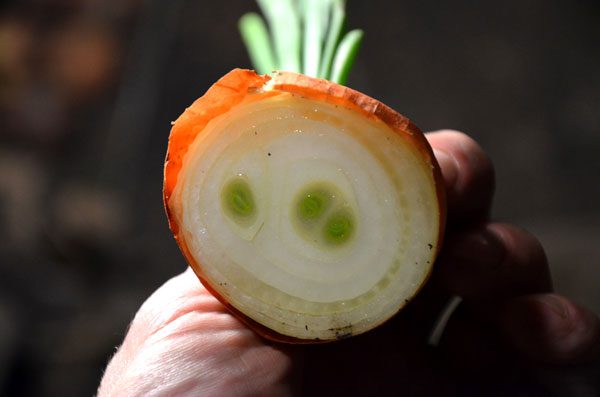
Multi-bud onions suitable for forcing feathers
And yet, the best guarantor of quality seed bulbs is a conscientious, reliable, experienced supplier. Then quality checks tend to be minimal, and good result - to the maximum.
Greenhouse onion care
Thanks to the knowledge of the simple rules of care, the question of how to grow onions on a feather in a greenhouse in winter does not arise. This culture is unpretentious and easy to grow. For effective growth, a number of basic principles are observed:
- timely and moderate watering;
- no weeds in the soil, loosening it for a full flow of oxygen;
- airing the greenhouse without creating drafts (even a small through breeze can be harmful);
- applying the required amount of fertilizer to the soil before planting and during the growth of the crop;
- ensuring optimal air humidity (within 75-80%).
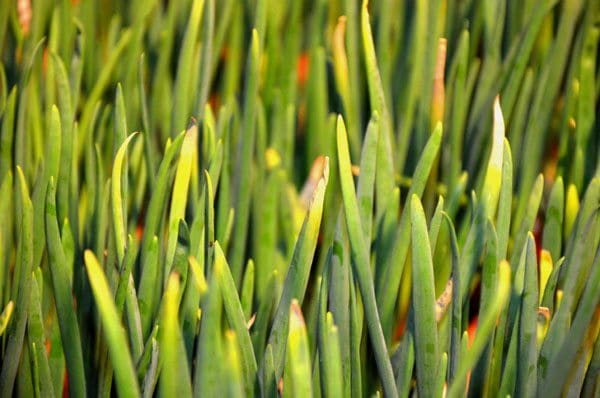
Plant condition that is best avoided
In the event of diseases or pests, due to the short period of feather rearing, the use of chemicals is prohibited. Therefore, some preventive measures are taken, since the defeat of the greenery by the disease can nullify the whole business idea.
Disinfection is carried out in the greenhouse before planting. During growth, if a bush is found with the slightest suspicious damage, it is removed, the place of growth is treated with wood ash, and the soil under it is completely replaced.
Sale and sale of onions
In the planning of most business projects, the main component is not only to produce a product, but, most importantly, to sell it profitably. The onion feather situation is no exception in this sense. Vegetable growers who grow green onions in a greenhouse for sale in winter can go two ways as to which variety is more profitable and faster to sell.
Market research will show the specific type or types of green onion that is in demand in the region. Then they are engaged in the cultivation of this variety and find their customers. Or another way, opposite to the first one - they grow varieties of feathers not widespread in the vicinity, creating a demand for it. This option is more risky and long-term, but ultimately more profitable, exclusive and interesting.
The fabulously unreal expression "grows by leaps and bounds" has a very real relationship to green onions. After all, approximately in just 3-4 weeks, the stems are cut with a length of 25-35 cm! Therefore, they worry about points of sale and sales in advance, even before landing. The options are:
- Wholesale bases. The disadvantage of this method is low and sometimes very low prices. But large sales volumes.
- Workshops that pack greens for delivery to supermarkets, hypermarkets.
- Opening of a personal point of sale for greenery. Then they expand the range of products and take into account additional costs (payment for rented premises, seller's salary, and others).
- Selling on the market using our own resources. It takes a lot of time, the volumes are not large, but the profit is high.

Good and budget option for packaging goods
In the case of the last two points, they try to pack the onions carefully. A good rule of thumb is to put yourself in the shoes of the other. In what form do potential buyers want the onion?
Video: onions in the greenhouse all year round
Of course, having mastered and established a successful mini-enterprise for growing onion greens, they do not always stop at the achieved level. The cultivation of onion feathers goes well with other types of greens. When the assortment of goods is expanded, new customers appear and existing ones are also pleased with the fresh additional offers.
It would seem that it is possible to invent a supernova in a long-studied and successfully applied business? Watching this video will help you find new facets.
Video: Surprisingly unconventional approach to the work of an active enthusiast
Video: Green Onion Business
Video: Feather onions for sale in winter
The simplicity of arranging a greenhouse for growing onions, quick harvesting, year-round availability of products makes this crop an attractive tool for organizing a business, even for beginners. Beginning entrepreneurs are still recommended to consult with more experienced and professional gardeners regarding the correct choice of planting material, planting method and other important points. Then there is no need to regret any possible mistakes.
I foresee the perplexing questions of seasoned gardeners. Is anyone else wondering how to properly plant onions on greens? What's so hard about that? Stuck in the ground, water and then weed. Indeed, this is exactly how they plant onions on a feather in dachas. As a result, there is enough greenery for the family.
Why not improve the result? Then the tender feathers of the onion will be enough both for yourself and for sale. I'll tell you how you can approach the issue from a scientific point of view and give you step-by-step instructions.
Step one - choose the onion variety
Most gardeners go in two ways when choosing planting material. Either they buy small onions, or they use semi-rotten and unsuitable bulbs. Both approaches have the right to be applied, but if you want to get a large harvest of greens, you need to choose a different tactic.
The best option for planting on greens is multi-leaf onion varieties.
Their peculiarity is that from three to five leaves sprout from each rudiment, which means that you will get more harvest. In addition, such varieties, in most cases, do not have the bulbs we are used to, all the power will go into the feather. What types of onions are best for you?
Chives for growing on a feather
Perennial varieties, have a high growth rate of leaves and excellent branching. Up to two or three cuts per season are allowed. They can be grown in the same place for five years, it is convenient for owners of small gardens.
Variety "Albion".Designed for cultivation in home gardens and small farms. From one onion, 2-3 leaves are obtained, each of which reaches 38 cm in size. It is unpretentious in care, tolerates frost well, and can be grown throughout Russia. The yield from one cut is 2 Kg per square meter, for the season from the same area you can collect 5 Kg.
Variety "Spring of the North". Designed for cultivation in personal subsidiary plots, tolerates winter well, is not afraid of frost. Forms 3-4 leaves, each up to 40 cm high.It has a semi-sharp taste, the yield per season is about 4.5 kg per square meter.
Variety "Mirage". From one onion, you get four leaves, each 40 cm long. The green onion tastes pungent. The yield from one cut is up to 1.9 kg per square meter. The onion tolerates winter well, you can not be afraid for its safety in severe frosts.
Leek on a feather
Leeks are also suitable for growing greens. Usually these are biennial varieties that can provide leaves for your family and sell surplus. They winter well in the open field, are planted in the spring with seedlings.
Alligator variety.Foliage can be used both in fresh, and for conservation. The length of the bleached part is about 4 cm, and the weight of one plant is up to 300 g. If you plant this type of onion on greens, you will get about 3.4 kg per square meter per season.
Grade "Gulliver".It has the same consumer qualities as the previous variety, but the length of the bleached part is 25 cm. It has a higher yield, in comparison with the Alligator, from one square meter, with proper care, you can get 4.2 kg delicious greens.
Sort "Shogun". Differs in dense arrangement of leaves, therefore, has a high yield. From one square meter of the garden you can get 4.5 kg greenery. True, this variety belongs to the middle late.
Slime onion on a feather
Slime onions are good because they begin the growing season as soon as the snow melts. Having planted it before winter, the first harvest can be obtained by April-May. I will tell you what varieties of onions are recommended by the Russian Rosreestr for use in a personal subsidiary farm.
Vals variety.An early ripe and winter-hardy variety with a high yield 4.2 kg / m 2 beds. In this case, the average weight of one plant is from 300 to 900 g. This value depends on the climatic conditions of the year of cultivation and the characteristics of agricultural technology.
It grows in 28-30 days, has flat and wide leaves, pleasant green color, with a slight waxy bloom. The taste of the feather is mild, therefore it is suitable for fresh consumption.
Grade "Green".It is recommended for cultivation in the conditions of a subsidiary and a farm, it has a relatively high yield and a six-year period of using the beds for commercial purposes. That is, you can grow both for yourself and for sale - a pen is enough for everyone.
The plant is compact, slightly spreading. The leaves are large, juicy, tender, green or light green in color. The yield is about 4-5 kg \u200b\u200b/ m 2 per cut... The variety is resistant to diseases such as rust and downy mildew, and feels good even under extreme conditions.
Variety "Leader".Suitable for growing in a garden, vegetable garden, small farms. Refers to mid-season varieties, the interval between the first shoots and suitability for cutting is 38-41 days.
Does not form bulbs. Differs in winter hardiness. The yield is up to 2 kg / m 2 per cut or 3.2 kg / m 2 per season. Among the advantages, it can be noted that the leaves grow together, which is on hand when growing onions for sale.
All varieties of slime onions approved by Rosreestr have excellent winter hardiness and are suitable for growing practically throughout the entire territory of the Russian Federation, regardless of local climatic conditions.
Shallots on greens
On almost all sites I read that this type of onion is suitable for growing on greens, but I cannot agree with this. Judging by Rosreestr, shallots are suitable for growing on a turnip (onion), and greens are a secondary matter. Shallots will be a good option for growing in apartments on the window, but for getting a feather in the garden is not the right decision.
Chives for greens
The chives are also known as skoroda, chives and sibulet. Used for decorative purposes, but also suitable for growing on a feather. Differs in excellent winter hardiness and early growing season.

Variety "Albion".Suitable for cultivation in private farms and small farms. From the first shoots to the moment of cutting the leaves, only 20-25 days pass, given the early start of the growing season, you can get spicy greens already in March-May, depending on the region.
It grows as a powerful bush, strongly branches. The leaves are narrow, reaching a height of 38 cm. In one season, 3-4 cuts can be carried out, collecting 1.7-2 kg / m 2 of each crop. As a result, up to 5 kg of a feather will be obtained from each square meter.
Variety "Lilac ringing". Early ripe, from the moment of germination to the first cut, 18-20 days pass. The bush is powerful, branched, with a leaf height of up to 62 cm. The taste is weak, so the onion is used for canning and fresh consumption.
The yield is very high. Several cuts can be carried out per season, while the total yield will be about 7 kg / m 2... Lilac ringing onions are not afraid of frost.
Step two - preparing the garden
A bed for growing onions on a feather must be prepared in the fall. Choose a place that is well lit by the sun and not flooded with rain. Check it out. To grow onions, it is necessary that the soil has a reaction at the pH of 6.4-7.9. If it turns out that the soil has an acidic reaction, add 5 kg of lime, dolomite flour or ground chalk to each hundred square meters.
Then add humus in the amount of 5 kg / m 2. Remember that lime is not “friendly” with organic fertilizers. This neighborhood causes the loss of nitrogen, which is necessary for the full growth of onions.
Therefore, if you need to lower the acidity of the soil, use ground chalk or refuse to introduce organic matter.
After you spread fertilizer over the beds, the soil must be plowed or dug to a depth of 20 cm. The second option is preferable, especially if plowing is carried out with a walk-behind tractor. When digging, you mix the soil layers more evenly and, at the same time, you can remove the roots of perennial weeds.
In the spring, apply mineral fertilizers (the dosage is indicated for 1 m 2):
- superphosphate - 60 g;
- urea - 10 g;
- potassium chloride - 20 g.
After fertilizing, the bed must be dug up again.
When preparing a bed for growing onions on a feather, you cannot apply organic fertilizers directly in the year of planting. In this case, the growth of the feather will be provided by the suppression of the root system and the harvest may be less.
Disinfect the soil a week before the intended sowing. To do this, prepare a solution copper sulfate at the rate of 20 g per 10 liters of water. It is more convenient to water the prepared beds with a regular watering can.
Step three - prepare the onions for planting
The purpose of preparing planting material is to accelerate plant growth and protect it from disease. This is the guarantee of a rich harvest. What can be done to accelerate growth and germination?
- Moisten the bulbs with warm water, wrap them in burlap and incubate for 48 hours at a temperature of 25 ° C. This will accelerate germination.
- Trim the tops of the bulbs by a quarter. This will provide air access to the kidneys, they will begin to develop faster.
- Make a solution of ammonium nitrate (30g / 10l) and keep the bulbs in it for 16 hours at a temperature of 35-38 ° C. This is a growth stimulant.
To protect the onions from diseases - you can dry the bulbs at a temperature of 40 0 \u200b\u200bС for eight hours.
Step four - choose a landing method
To obtain good harvest green onions need to choose the right planting method. There are only two of them - pavement and tape. What is the difference between them?
Bridge way of landing
Most likely, this method is known to all experienced gardeners. Its essence lies in the dense planting of onions - that is, the bulbs are located close to each other. In this case, there are no aisles. No furrows are needed for planting, the bulb is simply placed on the bed with the rhizome down.
With such a planting scheme, the development of the underground part of the plant is inhibited, and all the power goes to the feather. In addition, it turns out to place a large number of plants in a small area. According to the norms, about 13 kg of onion sets are needed per 1 square meter of the garden.
This method has two drawbacks. First, it is not suitable for residents on a budget. The average cost of onion sevka is 150 r / kg, that is, about 2,000 rubles should be spent on 1 m 2. Secondly, with this approach, it is difficult to care for the garden bed. In my opinion, the bridge method of planting onions on greens is suitable for owners of large greenhouses who have been growing greens for several years.
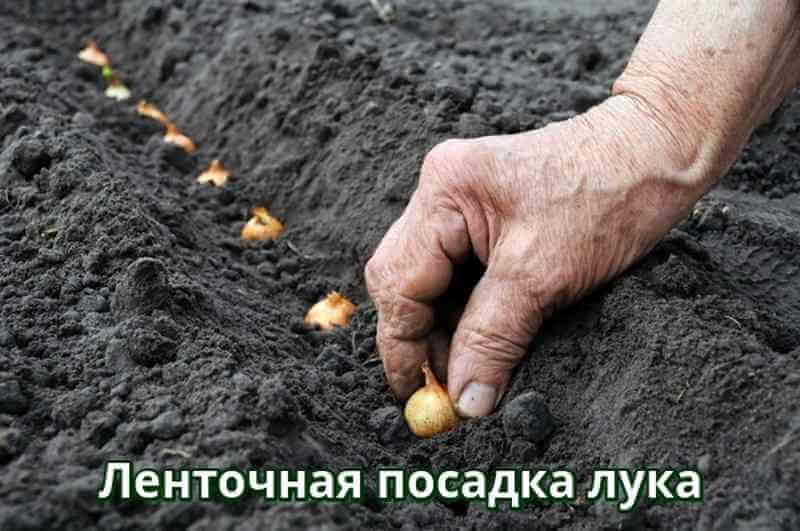
Belt landing method
With the strip method of planting onions, the distance between the bulbs is 1-4 cm, and the row spacing is 10-20 cm. The onions are planted in specially prepared furrows, then they are covered with soil. The layer thickness should not exceed 2-3 cm, otherwise plant growth will be delayed.
In my opinion, the belt method also has a disadvantage, which is the irrational distribution of the "strength" of the plant. A distance of 1-4 cm allows the underground part of the plant to develop actively, and to the detriment of the above-ground part.
This method is suitable if you are using a turnip to grow onions for herbs.
Combined landing method
I don’t know, maybe it’s called something different and, most likely, is known not only to me. But I tried to combine the bridge method with the belt method, planted the sevok at the end of March, now (May 2) my wife and I are eating greens with might and main. What I've done?
I made grooves about 3 cm deep. The width of the beds I have is about 1 meter, and the distance in the row spacing is 10 cm. The onions were planted close to each other, this is similar to the bridge method. The bulbs themselves were sprinkled with a layer of earth, 2-3 cm thick.
As a result, the bed is easy to care for, its width allows you to pull the weeds without trampling the ground and without straining. The onion rose together, now the height of each leaf is about 20 cm. That is, we provided ourselves with onions for greens. Try my method, and write about the results in the comments.
Step five - onion care
Regardless of the onion variety you choose, the cultivation technique will be approximately the same. There is nothing complicated, the main thing is to remember where this plant comes from.
The homeland of onions is considered Southeast Asia... This is a region with a rather extreme climate, where prolonged rains give way to prolonged drought, and heat - frost. Therefore, special attention should be paid to watering.
Lack of moisture results in bitter feathers and weak plants. Excess moisture causes root rot and, accordingly, the death of the onion. Therefore, it is important to observe the golden mean, not to overmoisten the soil, but also not to turn it into a desert.
It is believed that onions grown for greens should be watered no more than twice a week. In fact this is not true. Focus on climatic conditions, because in dry weather, watering needs to be increased, and with prolonged rains, stop altogether.
How to understand that the onion needs to be watered? Everything is very simple: insert your finger into the ground to a depth of about 2-3 cm.If you feel that there is moisture inside - you do not need to water, but if the soil is dry even at this depth - grab the watering can.
Another important point: all gardeners know that it is impossible to water plants in the heat, so many do it in the morning. I think this approach is a big mistake and here's why. If you water the onions in the morning, moisture will build up in the soil. By lunchtime, it will not have time to completely evaporate, so the thermal conductivity of the garden will increase. That is, the soil will warm up to a great depth. The bulbs are very sensitive to high temperatures and can die in this situation. Therefore, it is better to water the onions in the evening.
If you do not have the opportunity to water in the evenings, make shallow grooves in the aisles and carefully pour water into them. In this case, the overheating of the soil will not be significant.
Briefly about dressing
You do not need to apply any fertilizers at first. You did this when preparing the garden, there are enough nutrients for the period of plant growth. In addition, when growing onions for greens, it is undesirable to introduce any chemical agents so as not to harm your body.
One good way to improve growth is by sprinkling with sodium chloride solution. The main thing is not to overdo it and not "oversalt" the soil. Prepare a weak solution by dissolving 300 g of salt in 10 liters of water and watering the onion no more than three times per season. Why is this necessary, because salt is not a fertilizer?
Firstly, salt is considered an excellent growth stimulant. Secondly, it is an excellent tool for killing wireworms and onions.
Fighting diseases
Onions grown for feathers are often affected by downy mildew. The pathogen activates from mid-May, spreads through the air and with watering or rain, leads to wilting and yellowing of the feather. The only control measure is to immediately dig up the affected plant and then burn it.
The causative agent of the disease is found in the bulbs. Therefore, in order to prevent peronosporosis, warm the bulbs before planting for eight hours at a temperature of 40 0 \u200b\u200bC. With this treatment, the pathogen dies. Another option is to select a disease resistant strain.

The remaining agricultural measures are to regularly loosen the soil and remove weeds. Make sure that the onion does not overgrow. As soon as the plant reaches a height of 25-40 cm (depending on the variety you choose), you need to dig it up, shake it off the ground and put it in the box with its roots down. After that, the feather can be sold or processed for further consumption.
How to grow onions for greens in winter?
If you already have a bed of spring onions, and also have a greenhouse, it will not be difficult to get a feather in winter. To do this, before the onset of the first frost, dig up the plants and, together with a lump of earth, transfer them to the greenhouse.
Place the dug out onions under the racks or directly on the ground (depending on your greenhouse type) tightly together. Then pour a solution of cow manure prepared at a ratio of 1:10. This measure will help the onions take root faster in a new place, which means you will get a harvest earlier.
Remember that when forcing onions onto feathers, the temperature in the greenhouse should be between 14-16 0 C.
By the way, you can do the same with chives if you use 2-3 year old plants. A feather grown in this way is of high quality, and you can easily sell it in the winter season.
Summarize the material
If you are too lazy to re-read the article again, I will make a short summary in the form step by step instructions... So, to grow onions for herbs, you need:
- Choose the right variety (use the State Register of Breeding Achievements).
- Prepare the beds, destroy weeds, apply fertilizers.
- Prepare the bulbs for planting.
- Plant the sevok using a bridge, tape or combined method.
- Water, loosen, remove weeds in a timely manner.
Onion greens are a storehouse of many beneficial vitamins and minerals. That is why they love to plant it not only in open land, but also in greenhouses, hotbeds, and even at home on balconies. It is possible to grow onions for greens from seeds on your own, following simple algorithms for caring for a vegetable crop during planting in order to get useful fragrant feathers.
With the help of this plant, cooked dishes become tastier and more appetizing, it contains a lot of ascorbic acid. In order to create immunity for your family against viral and colds in winter and spring, it is important to know how to grow onions for herbs.
What types and varieties of onions can bring abundant greens
Growing onions for greens in a greenhouse or greenhouse makes it possible, regardless of the season, to serve fresh herbs to the table, add them to your favorite dishes and enjoy the spring taste and aroma, in addition, get a charge of vitamins that are so useful in winter and spring.
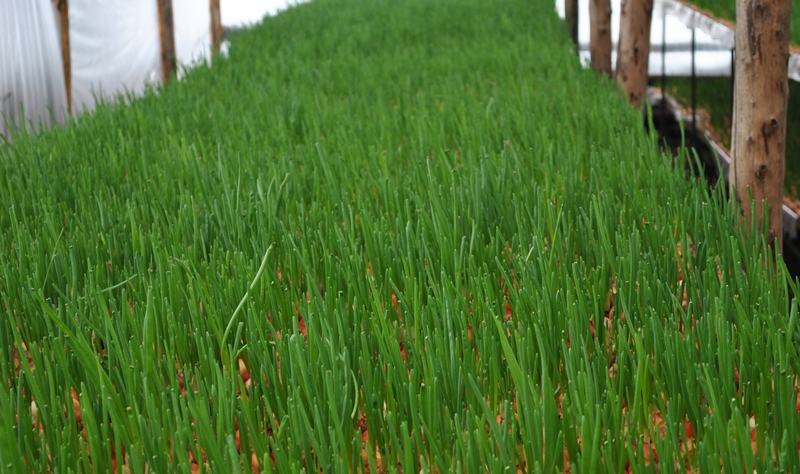
Important! Knowing how to grow onions for greens, you can create additional income that can bring, albeit small, but stable profit throughout all seasons.
Almost any caring hostess knows how to plant onions on greens on their own. To obtain useful greens, onions are planted in a container that is pre-filled with soil mixture, or you can lower the sprouted bulbs in containers filled with water. In this case, water should be regularly added so that the roots are covered with liquid. But if you plan to plant onions on a large scale, it is useful to know how and when to plant onions on greens in a greenhouse or greenhouse. In open soil, the sowing material is lowered from mid-spring to early autumn.
Such measures are carried out to find out the number of primordia in it. If only one resulting bud is observed, the plant will not please the harvest.
Most often, to plant onions on greens, the following varieties are purchased:
- Amber,
- Arzamas,
- Black Prince,
- Rostov.
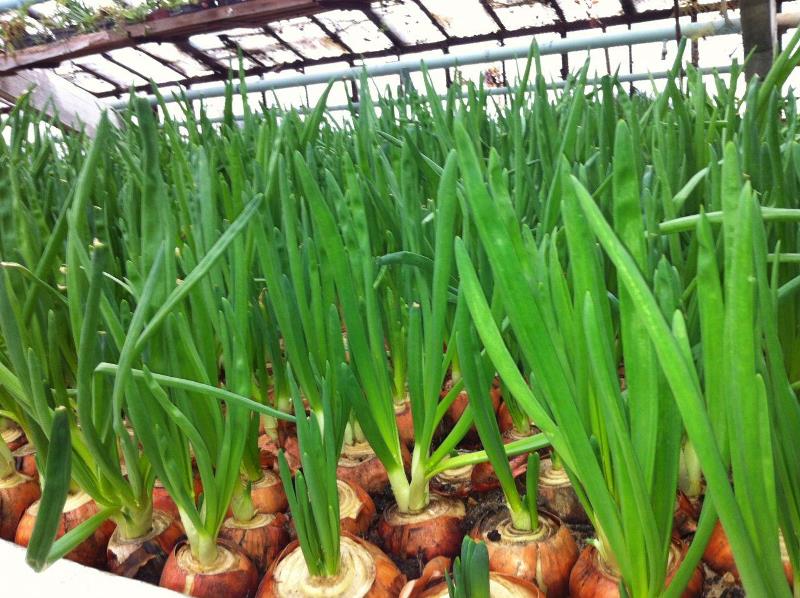
The most common varieties of onions
The most preferred onion seed varieties for planting on greens are:
- Batun onion. When it is planted, a bountiful harvest is obtained, the greens grow evenly. During the growing season, you can cut the greens several times. This applies to perennial plantings. The harvest can be obtained in quantities up to 30 kg from 9 square meters.
- Chives bow. After planting it, long fragrant feathers are obtained, they remain tender for a long time, do not harden. The yield is the same as that of the previous species.
- Leek. Its feathers resemble the leaves of garlic, they are saturated with a delicate taste. The yield of this type of onion is up to 20 kg.
- Shallot. The qualitative and quantitative indicators of the yield of this plant species are superior to the previous varieties. This type of onion is unpretentious, it does not require special planting and care conditions. At the same time, the yield is up to 45 kg from 9 square meters.
- Slime onion. It has wide flat feathers, which are distinguished by a delicate structure and a subtle garlic aroma. This variety is early maturing, frost-hardy, and brings a bountiful harvest. In greenhouse conditions, this variety grows throughout the year; in open ground, its growth stops after the onset of the first frost.
- Multi-tiered bow. It is considered the least demanding, frost-resistant type of onion, surpasses the previous types in terms of the amount of harvest. Its feathers do not die in frosty weather.
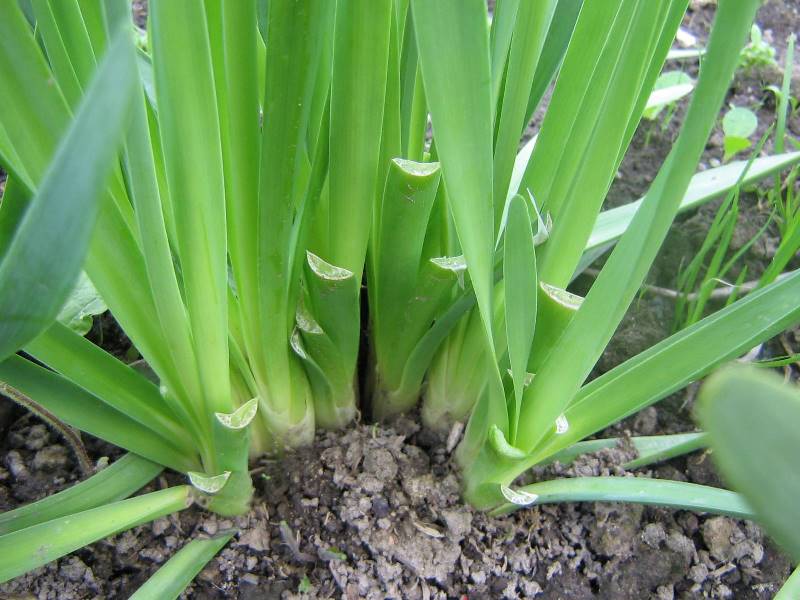
Any of these species can be planted not only in a greenhouse, but also at home, in a container way, to grow onion seeds for greens.
How to grow green onions in open soil
Different plant varieties are grown in a similar manner. The planting material is a multi-pronged bow, which does not exceed 4 centimeters in size. It is planted in open ground in the fall, about a few weeks before the onset of the first frost, or you can plant such an onion in the spring.
Important! Before planting, it is necessary to soak the bulbs in warm water for a day, then cut off the top from them.
With the help of such procedures, it is possible to achieve an acceleration in the growth of green feathers, to double the yield.
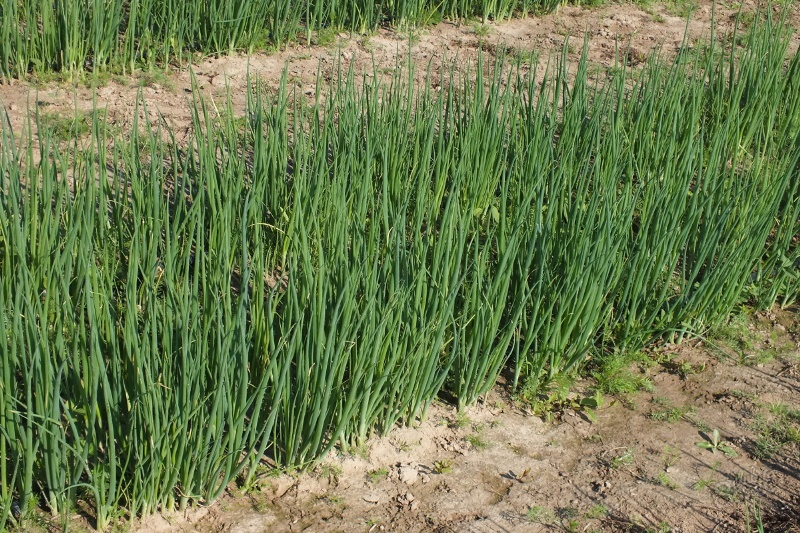
The plant is grown by the bridge method. It consists in planting the bulbs tightly to each other, with the roots down. Another method is tape. During planting, the beds are leveled in this way, the distance between the bulbs is increased up to 4 cm.When onions are planted in autumn, experts advise pouring a layer of manure or humus on top. In the spring, the fertilizer is removed, a film frame is installed over the bed.
How to grow onions from seeds
It is possible to plant onions on greens with the help of seeds. But this option requires more time. In terms of financial costs, such a landing is cheaper than the previous option, especially if planted perennial varieties Luke.
When to plant onions? In order for green feathers to grow in spring, onion seeds are lowered into the ground in the second decade of July. Before planting, soil preparation is carried out. It should be carefully loosened and fed with fertilizers. Before sowing, the bed should be leveled and compacted a little. Planting material is sown in rows, observing a row spacing of 40 cm.When the first shoots of planting appear, thin out.

Sowing seeds before winter, it is necessary to properly prepare the plant for wintering. To do this, mulch the soil with straw or peat. In the spring, when the snow melts, you can get the first bunches of juicy greenery.
How to plant onions on a feather (video)
Planting onions for greens in greenhouses or greenhouse
In the period from mid-autumn to mid-spring, it is possible to grow onions in greenhouses; from late winter to early May, it is more convenient to grow the plant in greenhouses. Landing is carried out only using the bridge option. For sowing, choose one-year or two-year seedlings or seeds. It is recommended to soak the bulbs in warm water, then they are laid on the ground. Sprinkle on top with a large amount of peat or compost, humus. If the tops of the onion have been cut off, it is not worth covering it with earth in greenhouse conditions.

A large number of crops will be yielded if the onions are planted in containers with compost, humus or peat. After landing in boxes or other containers, they are sprinkled with soil from above, wooden containers are placed on top of each other for several weeks. This makes it possible to functionally use the space in the greenhouse for planting other vegetable crops.
A few weeks after planting, boxes or other containers are distributed by sprouts throughout the room. It is necessary to control the air temperature. The most optimal is + 19 ° C. During the entire period of plant growth, it is necessary to water at least four times. In the intervals between waterings, crops are fertilized with the help of mineral fertilizers. It is better not to use chemical fertilizers when growing onions. The green feathers are harvested when they are 40 centimeters long.
Green onions: growing in boxes (video)
Gallery: green onions (15 photos)

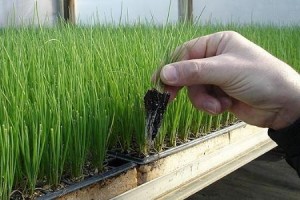
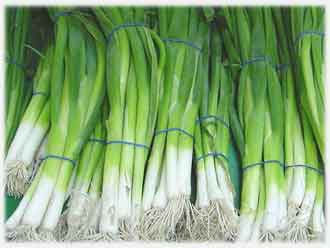
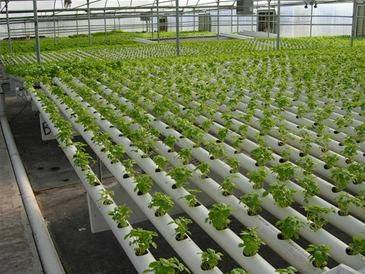


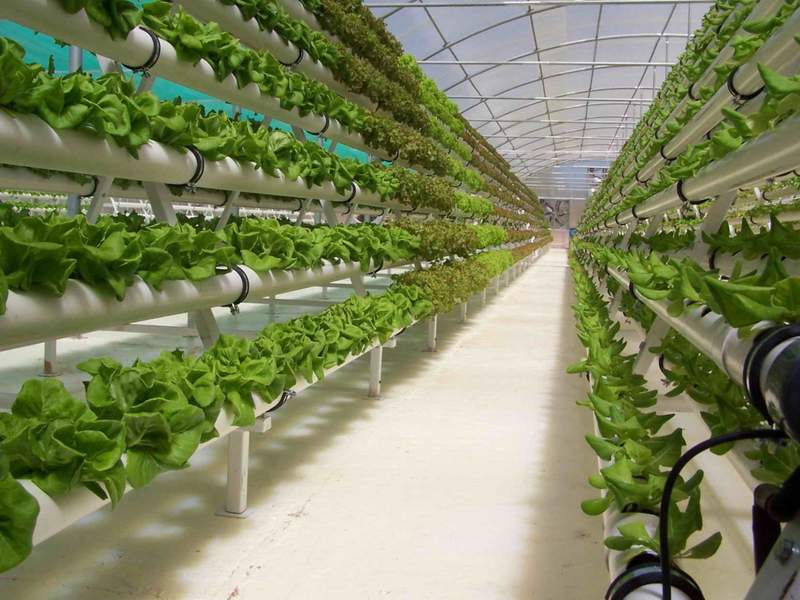
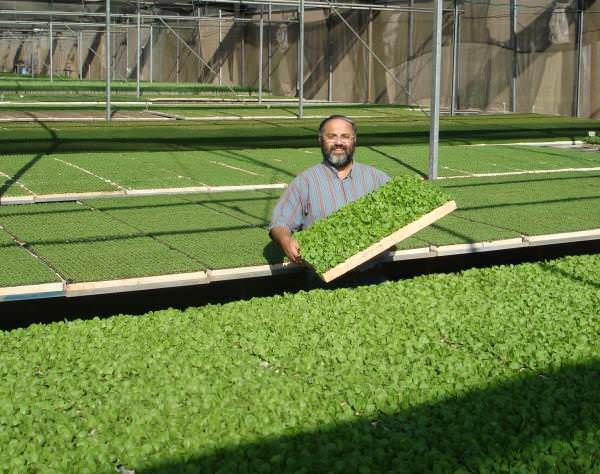

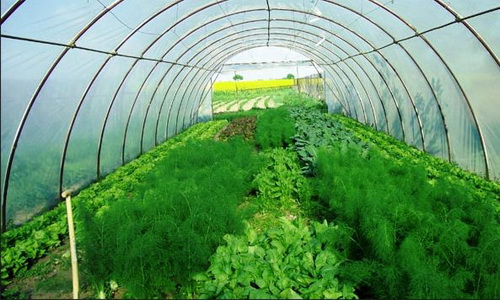

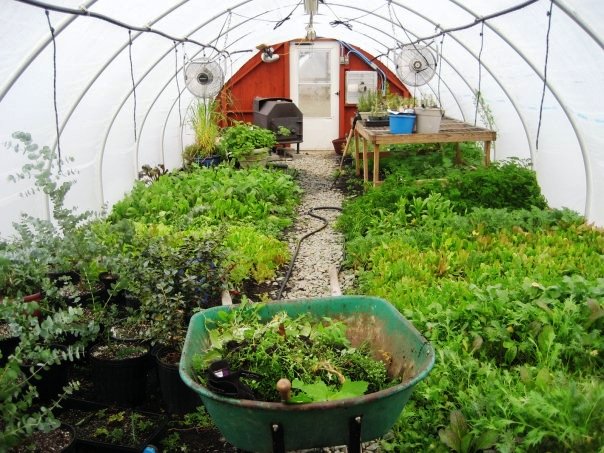
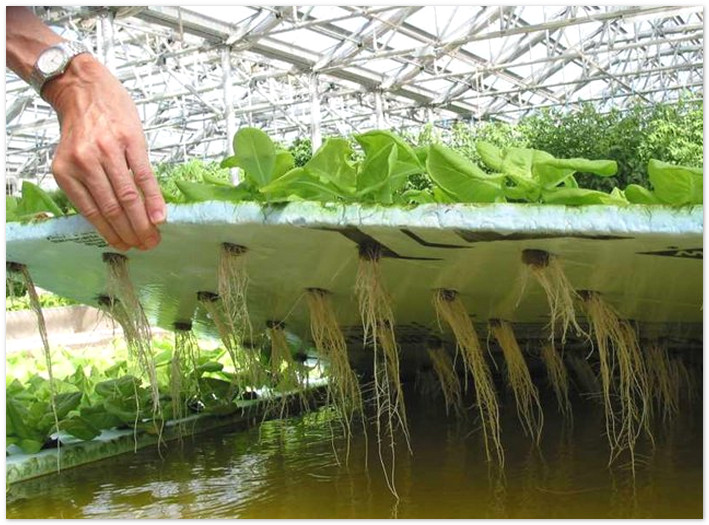


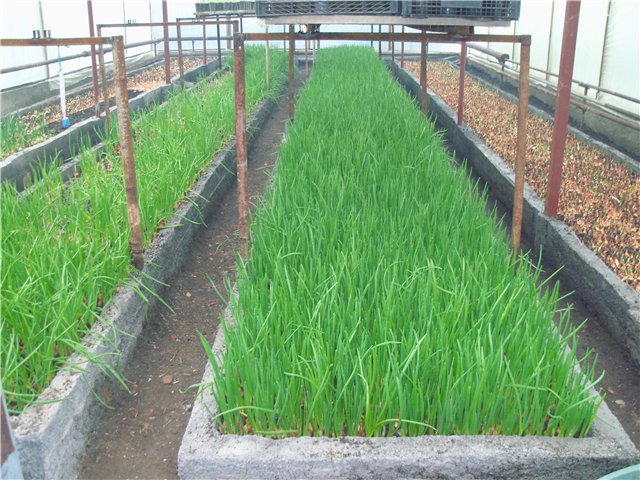
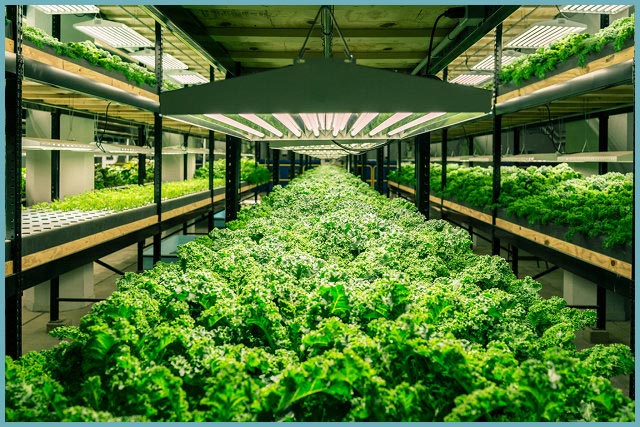
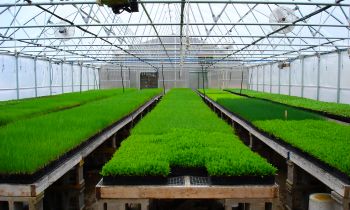
Onions are an integral part of most dishes, in which they can be used not only as an additional ingredient, but also as a main ingredient.
Indeed, this vegetable has not only good taste, which it receives after a special heat treatment, but is also extremely useful.
But even more useful and loved by everyone is not easy onion, but green, grown only for a feather.
After all, what can replace fresh herbs in early spring, if not rich in vitamins onions that can give vitality body frayed after a long winter.
It is no less popular for the external decoration of dishes, since it makes them spectacular and fresh.
Planting green onions: about the varieties and features of the preparation of materials
Growing green onions on a windowsill cannot be considered a relic of Soviet times, since such a product is not only a budget saving, but also a guarantee of environmental friendliness. It is in connection with the latter factor that many want to get all the vegetables from their own beds. Of course, in this case it is not always possible to have greens all year round, but you will not need to buy them all the time.
Choosing the best onion varieties that can be grown on a feather
You can grow green onions from absolutely all varieties. However, to obtain a large abundance of greens, it is better to choose the onion that has a large number of primordia. To do this, choosing an onion, if such an opportunity falls out, you can cut it across and independently determine the number of primordia.
However, you can simply choose the variety described below, which is the best in your opinion, and look for it.
Onion... Sometimes it can also be found under such names as fisty, winter, sandy or Tatar.
Very fruitfulonions with even beautiful greens.
When using perennial varieties of this onion, greens can be cut even 2-3 times during the entire growing season (in annuals, only 1 time).
The feather yield of this onion is about 20-35 kilograms from an area of \u200b\u200b9 m2.
Leek... This name is better known among the people, although sometimes such a name as pearl bow is used. The lower part is most often used, and many of the upper leaves are simply thrown away, but they have a very delicate taste. Outwardly, they have much in common with garlic leaves, but much wider than they.
From a 9 m2 garden bed, about 20 kilograms can be harvested, even if the plant is provided with the most minimal care.
Slime onion... The leaves of this onion also have some similarities to garlic. In particular, they have a spicy garlic flavor and a leaf structure that is flat and wide enough.
They are also distinguished by their delicate structure. The advantages of this onion are early maturity and high yield.
Also, due to its good resistance to frost, in closed ground it can yield yields all year round, and when grown in open beds it remains green until the very frost.
Chives... Occurs under more famous name - chisel. The main advantage of this type of onion is its leaves - thin and long, up to 50 centimeters. Also, they have a very good aroma and can be stored for a long period of time.
During storage, neither structure nor taste changes. It can be collected from a garden with an area of \u200b\u200b9 m2 up to 30 kilograms.
Tiered bow... Other names for this variety are Egyptian, Canadian. Among gardeners, it is considered the most whimsical and resistant to low temperatures.
Even the onion cannot compete with it in terms of yield and quality of the resulting greens. It can be left in the soil for the winter, while it is not damaged and easily begins to grow in the new season.
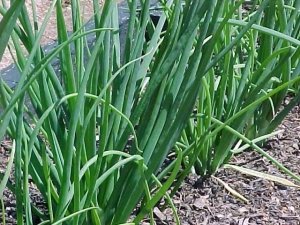
Shallot... Quite a well-known onion, widely used for cooking various dishes, and not just decorating them.
The leaves have not only good taste, but are also stored for a very long time without losing their juiciness.
In cultivation, this onion is not whimsical..
The yield of shallots can be different, ranging from 25 to 45 kilograms per 9 m2.
Also, it is worth mentioning such well-known varieties as Armazansky, Bezssonovsky, Rostovsky, Yantarny and of course the Black Prince onion.
We discuss the features of the conditions for growing onions on a feather
As you have seen from the description of feather onion varieties, almost all of them have good resistance, and not only to frost.
This bow is not whimsical enough. To grow a good onion head, you will have to apply a lot of fertilizer to the soil and provide necessary care, trying just to prevent it from being distilled into greens. Here is exactly what we need.
But still, try to provide the onion garden with enough sunlight or artificial light (after all, such onions are often grown both indoors and in greenhouses). He needs this both for acquiring a bright green color, but also for taste.
In very low light, onion leaves can of course stretch out and become very long, but in this case they will be very thin and not attractive both for dishes and for further sale on sale.
Also, when choosing a bed and a place in the garden for planting such onions, do not forget to make sure that the soil type has a good ability to retain moisture. However, do not lose sight of the fact that with a strong abundance of moisture, onions can also suffer and grow poorly (especially in the cold season). For this reason, do not plant this plant in an area where the water table can rise too high.
The type of soil for planting onions on an open bed may not play much, however, in greenhouses, when growing greens in boxes, it is better to use compost, humus or peat, which is covered with soil after planting the bulbs.
How to prepare onions for planting: basic rules and notes
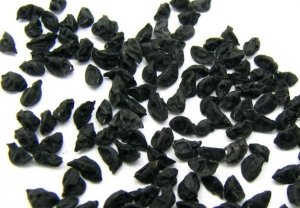
First of all, you need to clarify the fact that planting onions on a feather can be carried out not only with the help of onion sets, but also with seeds. In general, both methods give a good effect, the only difference is that onions are planted and sown at different times. And in the second case it will take much longer to wait for a new harvest.
When using bulbs as a planting material, they must be soaked in water before direct planting. This will help the bulb to absorb moisture, so that during the period of adaptation to growth in the new soil, it does not dry out and can give good results.
It is best to take those bulbs, the diameter of which is at least 2.5 centimeters, but not more than 4. Also, it is usually recommended to cut off the top from it. Thanks to such simple actions, it is possible to significantly influence the strength of the green distillation. It also contributes to an increase in the amount of greenery: in comparison with a simple planting without preparation of the material by 55-75%.
Growing onions for feathers from seeds, although more extended in time, is, however, a more budgetary way, significantly increasing your income if you are engaged in this business for sale.
Also, you can save money by purchasing perennial varieties of onions. Purchased seeds do not need to be prepared for planting: they are usually sold pre-processed, and not only for better seedlings, but also for a more resistant plant. Your seeds, as well as bulbs, can be pre-soaked in warm water, which will stimulate their growth.
We are preparing the soil and beds for planting onions
The soil requires special preparation for sowing onion seeds, however, the same procedures and actions can be carried out before planting onions on a feather using bulbs. So, the soil must be very carefully dug up - the deeper, the better. Deep digging is also needed in order to introduce a sufficient amount of organic matter into the soil, which will well stimulate the growth of onions.
Such onions usually do not need mineral fertilizers, although in the presence of very unfertile soil, it is best to use them. Before the sowing itself, the dug-up soil is well leveled and compacted a little so that the soil then does not sag along with the seeds, and even more so with the bulbs. The onion beds are usually not made wide, as it is believed that the narrower can achieve a higher yield.
The time and timing of planting onions, for growing them on a feather, in beds, in greenhouses and greenhouses
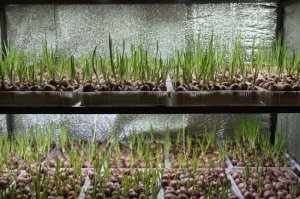
Planting time differences different types and there are practically no varieties. If it is planted in open ground, then this is usually done in late autumn, just before the very frosts.
Such a late time is needed so that the bulb does not have time to start growing, which is highly undesirable due to the approach of frost. But it is also very late to plant it, it is also impossible to plant it in the frozen soil, such bulbs will certainly suffer. Better to wait until the earliest spring, when the snow melts, and then plant your bulbs.
Also, growing onions on a feather can be carried out in greenhouses and in greenhouses. At the same time, green onions can grow well in the greenhouse during the entire cold period, delighting you with fresh vitamins. Usually it is grown in this way from October until April, when the greenery begins to appear in open beds.
But starting from February, you can plant bulbs in greenhouses, from which you can get greens until May.
If we are talking about sowing onion seeds for growing on a feather, then it is best to carry out this procedure in mid-July. This will allow you to get a good onion, or rather its succulent leaves, by the very early spring.
How to rationally use the area of \u200b\u200bthe garden for planting onions on a feather: discussing planting methods
There are two ways to plant bulbs for growing them on a feather, which are as follows:
- Bridge method. For this method, a very large amount of planting material is used, since the bulbs are very densely laid out next to each other, with their roots slightly burying their soil. After planting, such "bridges" are covered with a layer of soil of at least 2-3 centimeters (but not more, since a thick layer of soil will retard the development of the plant).
- Tape method. It consists in the fact that the bulbs are planted in specially and prematurely prepared furrows for this. The distance between the bulbs should be about 1-4 centimeters, but a space of 10-20 centimeters should be left between the rows.
With such a planting, at least 11-13 kilograms of bulbs are usually taken per 1 m2.
After planting, the beds are leveled, which allows you to fill the bulbs with soil.
Onion seeds are sown in a completely different way to obtain greens from them. For this, furrows are made on leveled beds with row spacing of at least 32-42 centimeters. Seeds are sown in these furrows completely, abundantly enough.
Of course, after sowing, the seedlings are very dense. Therefore, when real onion leaves appear above the surface, garden bedrecommended thin out... One plant is left at a distance of 3.5-5 centimeters.
Green onions and their care: what allows you to get high yields?
There is no doubt that the bow needs constant supervision and maintenance. After all, this will allow getting higher yields. In addition, when planting plants according to a certain scheme and taking into account its main needs, it is important to take into account other important aspects of agricultural technology, which involve loosening and watering the soil, feeding developing plants.
How often and why to loosen the soil of the beds with green onions?
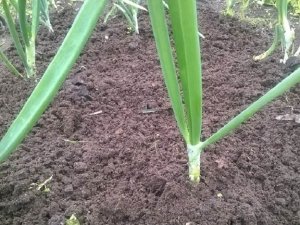
Loosening the soil is one of the most better ways delivery of oxygen to plant roots.
For this reason, loosening should be carried out quite often, in no case allowing the formation of a dense crust on the soil surface.
For this reason, on the second or third day after watering, you should definitely not forget about loosening.
Do onions need watering and what amounts of moisture will be useful for it?
The answer to the question posed will be unambiguous - of course they are needed. Moisture is one of the main nutrients for onions. With its help, other nutrients that are in the soil also get to the plant. Therefore, the optimal frequency of watering is about 2 times a week.
Of course, this will usually depend strongly on the type of soil and its ability to retain moisture in itself. Also, a large role in the frequency of watering is played by weather: in hot summer, watering is often carried out 3 times a week, in very rare cases and every day.
Also, the older the onion, the less watering it needs.
Feeding green onions: what fertilizers can you use?
Top dressing of onions is usually carried out in the form of irrigation using special solutions. The latter are prepared by adding either 1 gram of urea or nitroammophoska to 1 liter of water.
It is best to start feeding when you have already started cutting the greens. In this case, fertilizers will give the bulb the strength to regrow damaged feathers. If feeding is not used, then over time the onion leaves will become thinner and dimmer, their taste and aroma will be lost.
Weed removal: how not to run the beds?

Removing weeds from the beds is also important.
Indeed, with a large number of them, the plant may lack nutrients, especially if it is only planted onions or grown from seeds.
Thus, it is best to keep the soil on the bed black.
Also, when growing onions on a feather, the aisles are usually not used for growing dill, as is done when growing onions.
Onion care in the winter season: cover the beds with mulch
We already wrote above that onions are usually planted for the winter. Despite its good stability, it is still better to cover the beds with it.
If a podzimny planting of bulbs was used, then the bed is completely covered with a dense layer of 3.5-5 centimeters, consisting of manure or humus. In early spring, this layer is removed to allow the plants to develop. However, so that the cold does not affect their growth, it is better install a film frame over the bed, which will serve as something like a greenhouse.
When sowing seeds by the onset of winter, onion feathers usually reach a length of 20-30 centimeters. To preserve them, the beds need to be covered with straw or peat. With the arrival of heat, when it is already possible to remove the mulch, underneath it you will find fresh greens that will continue to grow due to the arrival of heat.
Was this helpful?
Well no
Popular varieties
To choose an onion for planting on greens, they look at the cross section, how many buds have formed inside it. If there is only one rudiment, there will be little greenery. Onion varieties should be chosen multi-primordial, such as Rostovsky, Arzamassky, Black Prince, Yantarny, Bessonovsky.
The following varieties of green onions have gained particular popularity:
- Schnitt. Its second name is chisel. It is prized for its leaves. They are fragrant, 50 cm long and narrow, do not stale for a long time, remaining tender. This bow is unpretentious to care for. Its yield is 30 kg per 9 m2.
- Leek, another name is pearl. The feathers of such onions resemble garlic ones. It has wide leaves and a delicate taste. The leek yield per 9 m2 is 20 kg. The variety is known as fisty, sandy, Tatar, or winter.
- Batunniy. His greens are even. The cost for planting is quite low. The feathers of this perennial onion are cut 2-3 times per season, in the annual only 1 time. Harvest from 9 m2 from 20 to 35 kg.
- Slime. This onion has wide and flat leaves, a delicate texture and a slight garlic aroma. The variety ripens quickly, is frost-resistant, fruitful. Indoors it grows all year round; outdoors it stops growing with the onset of cold weather.
- Shallot. Surpasses onions in quality and quantity of their feathers. Unpretentious to care for and very productive: 25-45 kg per 9 m2.
- Multi-tiered. Another name is Egyptian, Canadian. Of all the varieties, the multi-tiered one is more unpretentious and frost-resistant. The quality of the greens is much higher than that of the batun.
- Tape
The bulbs are planted 1-4 cm apart, the distance between the grooves is 10-20 cm. Then the bed is leveled.
If you land before winter, manure or humus is laid out on top. In the spring, the fertilizer should be removed and a frame covered with a film should be placed over the beds.
When planting, you can also use green onion seeds, planting them takes a little longer, but costs less.
In order to have fresh, fragrant greens on your table in the spring, sowing onions in open ground should be in mid-July. First you need to loosen the soil and fertilize it. Before placing seeds in the ground, the bed is leveled and compacted. Sowing onions should be solid, while maintaining a distance between the beds of 30-40 cm. After the appearance of the first leaf, the crops must be thinned so that the distance between the shoots is at least 3.5 cm. For the winter, when the feathers grow to 20-30 cm, the soil will need to be covered with straw or peat. After the snow melts, you will have a wonderful harvest of greenery.
Growing in greenhouses and greenhouses
In greenhouse conditions, green onions are grown in October-April, and from February to May in a greenhouse. They sit down only by the bridge method. The bulbs soaked in warm water are placed tightly in the grooves. Can be covered with peat or humus. In the greenhouse, do not sprinkle the onions with cut-off tops.
You can plant the onions in boxes filled with compost or humus. This will increase the yield. Asthenia planted in boxes is sprinkled with earth, and the boxes themselves are placed on top of each other and left in this position for 15-20 days. After that, the boxes are placed in the greenhouse and the temperature is monitored. It should be kept at a mark no higher than 19o. During the entire ripening season, the onions must be watered at least 4 times, fed with fertilizers between waterings. Chemical fertilizers cannot be used for green onions. Feathers are harvested at a length of 20-25 cm.
nasotke.ru
We plant onions in spring: timing, technology, care
Most gardeners who grow onions in their area eat mainly green leeks. And only a few of them grow onions for a turnip that can be stored for quite a long time. For these purposes, onions are planted in the spring. Compliance with simple rules will allow you to collect a guaranteed, large and high-quality harvest.
Landing dates
The landing site has been prepared since the fall. The soil is dug deep and fertilized abundantly with compost, manure or chicken droppings, at the rate of 1.5-2 buckets of organic matter for each square meter. Also, 25-35 g of superphosphate and potassium salts are added to 1 square meter. Good, large heads can be harvested from an area where pumpkin, zucchini, peas, tomatoes or potatoes previously grew. If you plant a set in the spring on a site after a carrot, beet, cucumber or garlic, then the heads will develop very slowly and the yield will decrease.
Onions are planted in spring, as soon as stable, warm weather is established and the soil warms up well. Since in insufficiently heated soil, below 12-14 ° C, the bow will go to the arrow. As a rule, the time for planting is chosen at the end of April - early May. A delay in sowing also negatively affects the yield, since due to high temperatures and a lack of moisture, the bulbs develop much more slowly. Many summer residents with extensive experience are guided by the planting time in the spring at the beginning of the flowering of the bird cherry.
Landing technology
Immediately before planting, well-dug beds are watered with a dark pink solution of potassium permanganate. In the future, until the end of the harvest, they no longer apply any fertilizers, but only monitor the cleanliness of the planting, timely removing all weeds.
Seed preparation
If the onion is grown on a feather, then it is planted with seeds. For 25-28 days before their sowing in the beds, a germination test is carried out - stratification. Then they are transferred to cheesecloth and placed in hot water 45-55 ° C for 12-16 minutes and immediately immersed for 1.5-2 minutes in the cold, carrying out the so-called hardening. Then the seed is kept for 22-26 hours in a cloth moistened with warm water, not allowing it to dry out. Then the seeds are soaked for 2-3 days, changing the water daily, and placed on the lower tier of the refrigerator, or in another cool place. At the same time, they swell and get rid of substances inhibiting germination. Before planting they are mixed with sawdust or sand.
Seeding preparation
If onion sets are planted in the spring on turnips, then the bulbs are sorted out and sorted by size. As a rule, large ones are planted first, then medium and small ones. It should be noted that large bulbs will go to the arrow, while small ones will grow large heads. 3-4 days before planting, the sorted planting material is dried and heated, spreading it in a thin layer at a heat source, no more than 35-42 ° C. Without heating and drying, all the onions will go to the arrows. After that, they are soaked for 8-10 hours in a weak solution of complex fertilizers, 15-20 g per 10 liters of water. Then they are placed in a solution (10-15 g per 10 l) of copper sulfate for the prevention of fungal diseases. Then washed and planted. To obtain a feather, the tip of the bulbs is cut off before planting.
Landing
Both seeds and seedlings are planted in spring in prepared, well-loosened beds. The seeds are planted according to the scheme with the distance between the beds 12-18 cm, between the onions 1.5-2 cm, and sealed to a depth of 1.8-2 cm.After that, the soil is watered and mulched with straw, sawdust or covered with a dark film to prevent its drying out.
The sevok is planted in the beds at a distance of 25-28 cm, between the bulbs 10-12 cm. It is planted to a depth of 4.5-5 cm, so that 2.5-3.5 cm of soil is above the shoulders of the bulbs. After that, the beds are watered and mulched.
![]()
Onion care
Lack of moisture in spring is especially noticeable on leeks, the feather becomes bluish, white, and the tips dry out and bend. With excess moisture or lack of light, the feather becomes paler and thinner. Therefore, moderate watering is important. After planting, in May-June, the beds are watered no more than 1-2 times a week, consuming 7-11 liters of water per 1 square meter.Then watering is reduced to 1 time in 1.5-2.5 weeks, since the head is maturing bulbs. However, in severe drought, in order to prevent wilting, the number of irrigations is increased, while reducing water consumption. Regular loosening of the beds, at least once every 2-2.5 weeks, will not only keep the planting clean, but also improve the air-humid regime, preventing the soil from over-compaction.
If the growth of feathers occurs slowly, additional feeding is added to stimulate growth, 250-280 g of bird droppings or mullein per bucket of water, 15-20 g of urea. This solution is consumed at the rate of 3-3.5 liters for each square meter. After 12-16 days, feeding is repeated. When the onion feather reaches 12-16 cm, preventive treatment for fungal diseases is carried out, for which the beds are sprayed with a solution of copper sulfate and liquid soap, 5-8 g per 10 liters of water.
Onions are harvested from the second or third week of August to September, when the feather died and the formation of new feathers stopped, and the heads acquired a characteristic color and formed. If you delay harvesting, the head will resume its growth and the onion will become unusable for storage.
Video "Preparing onion sets for planting"
In the video, a brief overview of some of the onion varieties. The process of preparing onion sets for planting is shown - selection of bulbs, processing, disinfection.
plodovie.ru
Planting onions is important - how to grow rich "green" crops?
When is the best time to plant onions on greens?
According to most gardeners, the best time to plant onions is when the weather is stable. And all because the soil should warm up properly. If the work is carried out earlier, when the soil temperature is below + 12-14 ° C, this will lead to the onion ripening into a feather (only greens will grow), and the bulbs will not develop. As a rule, the optimal timing for planting onion sets is the end of April.
But remember also that you should not be late with the planting of this culture. If the soil temperature is too high, the bulbs will ripen slowly and may not have time to form for normal storage. To find the right time, you can study moon calendar landings for 2016. According to him, a favorable time for disembarking a bow is after April 25. If you prefer the summer planting of the crop, you should choose either June 15 or July 13.
If you are going to spend autumn planting sevka, then you should choose mid-October, when the ground is not completely frozen. The favorable period for the work is October 10, but no later than the 15th. True, so that the onions do not freeze in winter, it is necessary to cover the beds with an additional layer of snow when the temperature drops below -12 ° C. And in early spring, before cleaning the beds, be sure to scatter the snow in different sidesto avoid stagnant water in the garden.
Processing of planting material - we make the onion more resistant
Having decided to plant onions in the area, the first step you must take is to prepare the seed. If you purchased onion sets, you need to dry them. The seed grown in your area should be warmed up at a temperature of about +40 ° C. At the same time, heating is a rather long process, which consists of two stages: we heat the bulbs for 21 days at a temperature of +20 ° C, we keep the onions for about 12 hours at a temperature of +35 ° C.
After that, you need to soak the sevok in a growth stimulator (for example, in Epine or Silke). If you do not have the opportunity to carry out a phased preparation of the seed, the processing of onions before planting will be as follows:
- soaking the onions in water heated to a temperature of +50 ° C for 15 minutes;
- immersing the seed in cold water for 10 minutes (this process is called hardening);
- processing of seedlings in a solution of complex fertilizer for 5 hours.
Another mandatory procedure before planting is the disinfection of the seedlings. For processing, you can use a weak solution of potassium permanganate or copper sulfate (to prepare the mixture, mix 40 g of the product in a bucket of water).
There is also one fairly effective "grandmother's" method:
- dry the seedlings for a week at a temperature of about +25 ° C;
- the next step is to soak the planting material in a saline solution (2 tablespoons of salt per 2 liters of water) for three hours;
- rinse the bulbs;
- immerse the seed in a concentrated solution of potassium permanganate for 2-3 hours;
- rinse again;
- dry the onions.
This completes the preparation of onion sets for greens.
Competent soil preparation for planting
Before preparing the soil for planting, you need to choose a suitable place for arranging the garden. It is important to remember that this culture is photophilous, therefore the place where the onion will grow should be open and well lit. In addition, this culture is moisture-loving, but does not withstand excessive amounts of water. That is why try to choose beds where groundwater does not pass.
Soil preparation begins in the fall. Onions love loose and nutritious soil, so you need to: dig up the beds to a depth of 20 cm; add peat compost. An important nuance - you need to fertilize the soil only at the stage of soil preparation. But organic fertilizers should not be added to the ground, since this will lead to the rapid growth of weeds, in addition, the green part of the onion will quickly grow, and the root system will not keep up with it. As a result, you won't be able to grow storage-friendly onions.
Before planting the seedlings, chicken manure or humus should not be added to the soil. Soil preparation also includes checking the acidity level of the soil. If the soil is acidic, before planting the seedlings, you should lime it using one of the following ingredients: dolomite flour, lime, chalk, wood ash. Do not forget about one important point - you should not simultaneously apply lime and manure to the garden bed, since as a result of such measures, the level of nitrogen in the fertilizer decreases. But it is permissible to reduce the acidity of the soil using other means, which we described above.
In the springtime, soil preparation consists in loosening the soil and adding mineral additives. Before planting onions (about a week), pour the following solution over the garden bed: a tablespoon of copper sulfate per 10 liters of water.
Planting onion sets - instructions for beginners
Before planting, be sure to sort the bulbs, since the distance between the seedlings in the beds is determined depending on the size of the planting material. The onion planting scheme should be as follows:
- bulbs up to 1 cm in size are placed in the garden at a distance of about 5 cm;
- bulbs up to 1.5 cm - at a distance of 8 cm;
- coarser seed - at a minimum distance of 10 cm.
If we talk about the beds, then they should be at a distance of at least 25 cm.The planting depth is about 4 cm.After the seedlings are immersed in the soil, the ground around the bulbs must be squeezed tightly, and the planting material itself is covered with a layer of mulch of about 3 cm.As a mulching material you can use straw, sawdust, peat or small stones. There is one "grandmother's secret": make a hole in the garden for planting onions, water it, and pour some sand on the bottom. According to gardeners, onions in such beds will grow much faster.
Onions, like other vegetables, have both desirable and undesirable "precursors". The desirable ones include cucumbers, cabbage, potatoes, as well as vegetables, when planted, a large amount of "organic matter" is introduced into the soil. Undesirable predecessors include carrots and garlic - in the beds where these crops grew, onions can be planted only after 3 years.
What should be the maintenance of the crop on the site?
Taking care of your onions won't get you in trouble. The main thing is timely weeding, loosening and watering of the plant. Let's take a closer look at each of the activities:
- Loosening. Correctly carry out work before the first shoots appear. The frequency of the event is once every 14 days, which will avoid the formation of an earthen crust in the garden.
- Watering. Immediately after planting the set, onions need to be watered once a week. There are about 7 liters of water per square meter of soil. Since July, the number of waterings has been reduced.
- Top dressing. Onions are one of the crops that practically does not need feeding, but there are several points. So, for the first time, you can apply fertilizer a couple of weeks after planting. Add a solution of 500 g of manure to 5 liters of water into the garden bed. You can also feed the onions with a solution of bird droppings - dissolve 500 g of droppings in 7 liters of water. As a top dressing, you can use dry mineral fertilizers (in the form of granules), which are simply sprinkled on the soil before watering.
Those gardeners who think that onion care should not include the removal of weeds are deeply mistaken. The area where you plan to grow the crop should be free of weeds. Otherwise, it will be quite problematic for you to get rid of them without damaging the onions when the greens grow. In addition to weeding, care should also include the use of chemicals that need to be treated with a plant bed. It is best to use the remedy Roundup, which effectively fights weeds and is safe for the plantings themselves.
Diseases and pests have a negative effect on both greens and bulbs. That is why the care of the culture should include measures to combat them. The most harmful insect is onion flour, which appears in May with the first shoots. To protect the onion from the invasion of this pest, be sure to treat the crops with insecticides. It is best to use means such as Zolon and Volaton.
Peronosporiosis is one of the most dangerous diseases for onions. This is an analogue of late blight, which affects tomatoes and other vegetables in the garden. With this disease, the greens begin to darken and dry, and the bulbs will be unsuitable for storage. The main way to fight the disease is by spraying with products such as Ridomil Gold and Acrobat.
nasotke.ru
Onions for greens in a greenhouse: growing rules
Growing onions in a cold greenhouse
It is best to plant green onions in a greenhouse after beets, carrots, eggplants, or tomatoes. Before planting, the soil is loosened, enriched with manure and compost, mineral fertilizers are added at the rate of 30 g of superphosphate and 15 g of potassium chloride per m². Then the soil is mixed and properly leveled.
The best varieties that allow you to get a good feather and give a large mass are Troitsky, Bessonovsky, Skopinsky, Spassky. The bulbs must be dry, free from damage, large enough, at least 3-5 cm in diameter, otherwise the greens will turn out to be unsightly.
It is recommended to plant the bulbs in the first half of October, then the plants will have time to take root well before the cold weather. Planting is done in rows, indentation - 2-2.5 cm, depth not more than 4 cm. After the onset of cold weather, the soil is covered with manure with straw or sphagnum peat. The thickness of the covering layer must be at least 15-20 cm.
Green onions are grown in greenhouses on an industrial scale, but an ordinary gardener can also do this.
In the spring, at the end of March, snow is removed from the surface, the greenhouse is covered with a film, and the insulating layer is removed. During feather formation, plants need regular watering and feeding. During the spring, mineral fertilizers should be applied twice at the rate of 10-15 g per m². Water as the soil dries up.
Important! Since onions sprout early, there is a danger of freezing them. Therefore, you need to ensure that there are no drafts in the greenhouse in the spring, the transoms should be opened two at a time, and, in no case, are not located opposite each other.
Mass shoots of greenery are observed in about a month, in late April - early May. If planting is carried out in the spring, then they do it only after the soil has completely thawed, and the greens appear two weeks later.
Even a novice grower can grow onions in a greenhouse.
The greens should be harvested along with the bulbs, this should be done at the moment when it reaches a height of 20 cm. The soil is shaken off the plants, and then the roots are cut off. The yield at a consumption of 8-13 kg per m² is 10-15 kg per m². In case of planting before winter, green onions are usually harvested in the first half of May, when spring planting - in the second.
Greenhouse green onions can be grown all year round if heated. Garden soil or peat is used for this. Heating the bulbs before planting at a temperature of 40 ° C during the day helps to increase the yield. After warming up, the neck must be cut off.
In a heated greenhouse, onions can grow all year round
In a heated greenhouse, onions should also be watered and fed regularly, in addition, a certain temperature regime should be ensured: 18-20 ° C during the day and 12-15 ° C at night. Since the length of the day is shorter in winter, additional lighting is needed in the second half of the forcing so that the duration of the light period is at least 12 hours. The bulbs should be placed vertically to avoid wrinkling the pen. With this technology, the crop can be removed in 25-30 days.
Leek
This onion is grown from seeds and is highly prized for its delicate smell and unusual taste. They use leeks, in addition, the white base is also eaten. The seeds are pre-soaked and then planted in pots 2/3 filled with soil. From above, the seeds are covered with soil and covered with polyethylene, then placed in a warm place. The pot is watered every three days by removing the bag and then putting it back on. After germination, the bag is removed and the plant is placed on a windowsill. Seedlings should be watered regularly.
Before planting this onion on a feather in a greenhouse, fertilize the soil with humus and ash. They are planted one plant at a time, at a distance of 8-10 cm from each other. In dry weather, leeks are watered, weeded from time to time.
Adding soil allows you to form a delicate and tasty white leg on the leek
To get a high white leg, you need to form grooves in the soil before planting and plant seedlings on the bottom, and as the plant grows, add soil to its base.
Shallot
A drought-resistant plant from the Mediterranean with a delicate aroma and pungent taste. The base of the plant is arranged like that of garlic: several small onions are united by a common shell. It propagates vegetatively, due to which it has a high ratio of the mass of the crop to the mass of planting material. Usually, when planting, a complex shallot bulb is divided into several (3-8) parts. Due to the overgrowth, the distance between them should be at least 15-16 cm. Planting can be done both in autumn and in spring, shallots ripen faster than onions.
Flowering shallots
Onion
The planting material of this plant is called false bulbs. It is convenient to grow it in a heated greenhouse in winter, as it is undemanding to the length of the day. In November, it will take 23-26 days for forcing this onion, January 20, February a little more than 2 weeks. It requires frequent watering, the humidity in the greenhouse should be 75-85%. The greens of the batun are smoother than those of onions, and the cost price is several times lower.
Growing onion is easier and more profitable than usual
Chives
Propagated by thickened rhizomes, which are formed in large quantities during the growing season, so it is easy to get planting material for this onion. In late autumn this material is dug up and left dormant for about 3 weeks. The onions can then be planted in the greenhouse. To awaken the plants, they are watered with warm water having a temperature of 35-40 ° C. The soil may not be fertilized, but its thickness when grown in boxes should be at least 10 cm. During germination, the temperature in the greenhouse should be 20-22 ° С, and during feather formation - 16-18 ° С.
In addition, sufficient light is required to form beautiful dark feathers. Watering chives should be regularly, in small portions, soil moisture should not exceed 80%, air - 70%. Too high humidity will negatively affect the quality of the feathers. The entire distillation takes 3-6 weeks, after which the greens can be cut off, and the underground part can be left to get a second harvest.
Chives grow in one place for several years
Growing onions in a greenhouse is an easy task; it is a rather unpretentious culture. Being a source of many vitamins, minerals and phytoncides, onion greens help support the body in the autumn-winter period, strengthen immunity and reduce the likelihood of colds. Moreover, this activity can be a profitable business, because the cost of bulbs and feathers differs by 10 times or more!
Growing onions is quite a lucrative business.
The most favorable time to sell green onions is New Year's holidays, Easter, February 23 and March 8, when there are many who want to decorate their table with this product.
teplicnik.ru
What kind of onion to plant in the country so that in early spring you can eat its delicate greens?
Galina
For early greens, perennial onions are suitable - chives (even later and will delight you with beautiful flowering), batun (very juicy), slime (with a weak garlic taste). There is also a multi-tiered one, but I did not plant it. So the choice is yours.
Yaoza
There is such a bow, we call it Kushchevka. Very delicate greens and a lot of them!
INQUISITOR TDV
There are winter varieties.
So they need to be harvested in the fall, so that there is a harvest in early spring!
ღ M @ rin @ ღ
Plant perennial bows - batun, chives, they sprout even when the snow has not completely melted. Only they are good from the end of spring - at the beginning of summer, then they go into the arrow and become coarse.
Alfiya Bakirova
Since January, we have been planting onions right on the windowsill (well, which is slightly purple). If it is well watered, such greens will trample !!!
Lyre
I plant onions at the beginning of April in a greenhouse, around the edge, the greens are juicy and fast. Soot "Family". Although you can any, except for small sevka of course. In general, I have planted a perennial onion. Only the snow is melting, but it has already hatched and grows quickly and until late autumn, no care is needed at all. The feather is a little harsh, but very fragrant. I even prepare it for the winter. Finely cut the feather and into the freezer.
Irinka
i plant a lilac family-onion along the edge of the beds, as soon as the severe frosts pass, after a week I pull it, along with the roots. and in its place I stick a new onion ... so over the summer I planted ten times ... just on the greens
Jeanne
plant ordinary medium-sized onions or samples (larger than a set), perennial varieties of onions such as chives, shallots ...
SlavuskaYa
You can plant Batun. Early green juicy fast-growing onion on a feather.
Olga
For spring, I plant onions before winter.And also delicious perennial chives in spring
Maya Kosenkova
Plant a slime onion - perennial, early tender greens, flat leaf
And multi-tiered onions are perennial and give early greens, but they are island
Ira L
i have a batun onion, I like it and leaving is not difficult
tatiana savchenko SIBERIA
I, in order to have a tasty green onion in the spring at the dacha, in August-September of the previous years I plant such bulbs 
this is a multi-tiered bow (perennial). The next year, its greens can already be either cut off for a feather, or dug up entirely. If you cut, you will later get 1 or 2 more greens. ... Its feather is much softer than that of a batun, and the taste is better.
Flute
There are a lot of bows and different ones. Plant slowly, then choose. ... I have chives, multi-tiered, anzur, sweet onions, bear onions,. family and sevok ...
Marina Crow
I had an onion that had thin feathers and bloomed with lilac flowers. I don't know what it's called. As soon as the snow melted, the young feather grew rapidly. And due to the fact that the feather is very thin - not rough, you can eat until frost and snow. Several piles grew in the front garden along with flowers, until they started repairing the terrace, then they trampled it down, filled it up, but in the spring I will take it from a neighbor.



